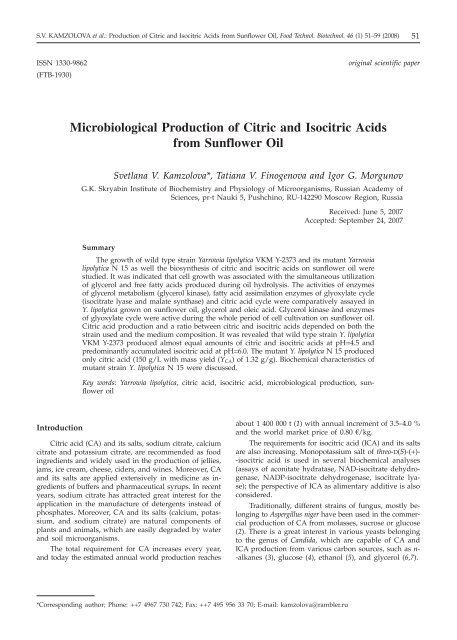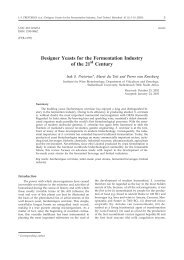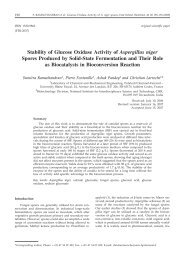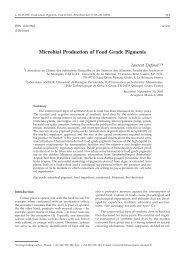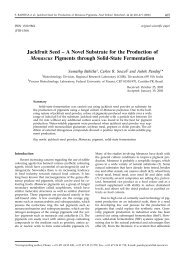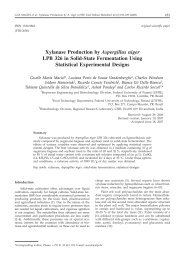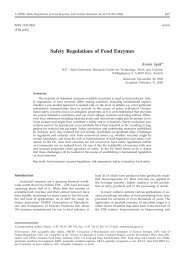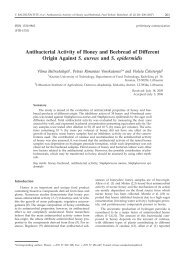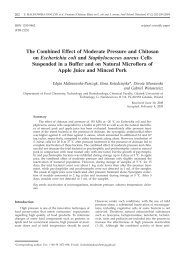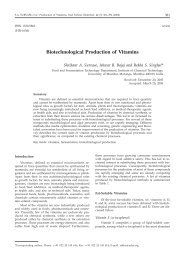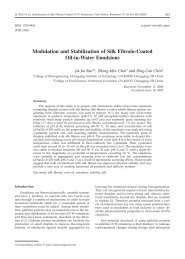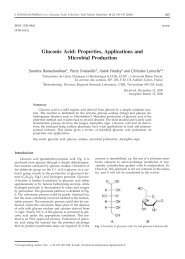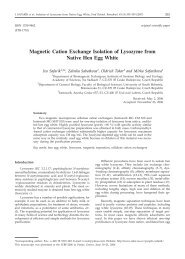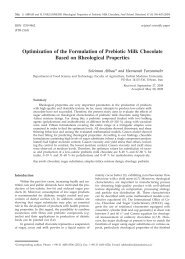Microbiological Production of Citric and Isocitric Acids from ...
Microbiological Production of Citric and Isocitric Acids from ...
Microbiological Production of Citric and Isocitric Acids from ...
You also want an ePaper? Increase the reach of your titles
YUMPU automatically turns print PDFs into web optimized ePapers that Google loves.
54 S.V. KAMZOLOVA et al.: <strong>Production</strong> <strong>of</strong> <strong>Citric</strong> <strong>and</strong> <strong>Isocitric</strong> <strong>Acids</strong> <strong>from</strong> Sunflower Oil, Food Technol. Biotechnol. 46 (1) 51–59 (2008)where X 2 <strong>and</strong> X 1 are the biomass at the moment <strong>of</strong> timet 2 <strong>and</strong> t 1 , respectively.The biomass yield was calculated as follows:Y X/S =X/S /2/where X is the total amount <strong>of</strong> biomass in the cultureliquid at the end <strong>of</strong> fermentation (g/L) <strong>and</strong> S is theamount <strong>of</strong> the consumed oil (g/L).The specific rates <strong>of</strong> CA <strong>and</strong> ICA production (q CA orq ICA , respectively) were calculated using the followingequation:q=(P/X) ⋅ t /3/where P is the total amount <strong>of</strong> CA or ICA in the cultureliquid at the end <strong>of</strong> fermentation (g), X is biomass contentin a fermentor at the end <strong>of</strong> fermentation (g), <strong>and</strong> tis fermentation time (h).The mass yield coefficients <strong>of</strong> CA or ICA productionwere calculated as follows:Y=P/S /4/where P is the total amount <strong>of</strong> CA or ICA in the cultureliquid at the end <strong>of</strong> fermentation (g), <strong>and</strong> S is theamount <strong>of</strong> consumed oil (g).The volumetric productivity <strong>of</strong> the process was calculatedusing the following equation:C=(P/V) ⋅ t /5/where P is the total amount <strong>of</strong> CA or ICA in the cultureliquid at the end <strong>of</strong> fermentation (g), V is the volume <strong>of</strong>fermentor (L), <strong>and</strong> t is fermentation time (h).Results <strong>and</strong> DiscussionProperties <strong>of</strong> wild type strain Y. lipolytica VKMY-2373 <strong>and</strong> the development <strong>of</strong> regime <strong>of</strong> oil feedingThe wild type strain Y. lipolytica was cultivated inthe complete medium containing 10 g/L <strong>of</strong> sunfloweroil <strong>and</strong> 5.0 g/L <strong>of</strong> (NH 4 ) 2 SO 4 in a 10-litre fermentor withinitial working volume <strong>of</strong> 5 L; pH=5.0 was adjusted automaticallywith 10–15 % NaOH. Fig. 1 illustrates a typicaltime course <strong>of</strong> growth <strong>of</strong> Y. lipolytica. Cell growth wasaccompanied by a decrease in the content <strong>of</strong> nitrogen<strong>and</strong> oil in the medium; 10 g/L <strong>of</strong> biomass were accumulatedat the end <strong>of</strong> fermentation (27 h) (Fig. 1a).The maximum specific growth rate (m max ) calculated<strong>from</strong> the linear segment <strong>of</strong> the growth curve (Fig. 1)amounted to 0.230 h –1 ; a value comparable with literaturedata obtained for Y. lipolytica grown on fatty acids(8,9). The biomass yield <strong>from</strong> the consumed oil (Y X/S )was 1.1 g/L. The above findings support the potential <strong>of</strong>Y. lipolytica for the production <strong>of</strong> single-cell protein <strong>from</strong>fatty material. High Y X/S <strong>of</strong> (1.1±0.3) g/L has been reportedfor different strains <strong>of</strong> Y. lipolytica cultivated onvarious types <strong>of</strong> crude fat (8,9,30,31). Recently, in experimentswith Y. lipolytica grown on completely saturatedfatty acid mixture (9), it has been demonstrated that anincrease in dissolved oxygen concentration <strong>from</strong> 5–15 to60–70 % <strong>of</strong> air saturation resulted in the increase <strong>of</strong> Y X/S<strong>from</strong> 1.1 to 1.6, whereas the lipid production decreasedat the same time. Moreover, the growth parameters appearedto be critically influenced by fatty acid composition<strong>of</strong> the carbon source. It was indicated that yeaststrains (Saccharomycopsis lipolytica <strong>and</strong> Apiotrichum curvatum)did not grow sufficiently well on saturated fat dueto inadequate dispersion <strong>of</strong> these substrates into the liquidmedium; solid fat required considerable agitation(1200 rpm) for dispersal in the growth medium (32,33).In other reports, it was observed that Y. lipolytica demonstratedsignificant growth without differentiations, regardless<strong>of</strong> the fatty acid composition <strong>of</strong> the culture medium(saturated free fatty acids, rapeseed oil <strong>and</strong> mixture <strong>of</strong>these two substrates) (8).The utilization <strong>of</strong> sunflower oil involved its hydrolysisby lipase that resulted in the formation <strong>of</strong> di- <strong>and</strong>monoglycerides, glycerol, <strong>and</strong> free fatty acids. The glycerolconcentration rapidly increased during the first 9 h<strong>of</strong> cultivation (up to 0.125 g/L) (Fig. 1b) <strong>and</strong> then remainedat this level. It should be noted that residual glycerolremained at the trace level as sunflower oil wasconsumed <strong>and</strong> no accumulation <strong>of</strong> glycerol was observed.Also, that a ratio among di-, monoglycerides, <strong>and</strong>free fatty acids in the culture broth remained at the constantlevel in the course <strong>of</strong> cultivation (data not shown).Analysis <strong>of</strong> free fatty acid composition revealed that inthe course <strong>of</strong> cultivation, the fractions <strong>of</strong> oleic acid(D 9 C 18:1 ) <strong>and</strong> linoleic acid (D 9,12 C 18:2 ) decreased <strong>from</strong> 36 to27 % <strong>and</strong> <strong>from</strong> 52.1 to 35.0 % (by mass), respectively,while the amount <strong>of</strong> stearic acid (C 18:0 ) increased <strong>from</strong>4.0 to 26.0 % (by mass). It may be considered that thestrong fatty acid specificity <strong>of</strong> Y. lipolytica was probablyg(biomass, oil)/(g/L)g(glycerol)/(g/L)141210864200.50.40.30.20.10OilNH 4+(a)Biomass0 3 6 9 12 15 18 21 24 27t/hC 18:2(b)C 18:1C 18:0C 16:0Glycerol0 3 6 9 12 15 18 21 24 271200t/hFig. 1. The growth <strong>of</strong> Y. lipolytica VKM Y-2373. Variation <strong>of</strong> sunfloweroil, biomass, nitrogen concentrations (a), glycerol <strong>and</strong> freefatty acids (b) with time. Cultivation conditions: 10 g/L <strong>of</strong> sunflower<strong>and</strong> 5.0 g/L <strong>of</strong> (NH 4 ) 2 SO 4 ; pH=5.09006003000706050403020100g(NH )/(mg/L)4 +w(fatty acids)/%
HEALTHTALK TRINITY HEALTH 5 • NOVEMBER 2007Trinity Health Goes Tobacco-Free November 15thCome November 15,Trinity Health will be atobacco-free zone –both inside <strong>and</strong> out.The Trinity HealthBoard <strong>of</strong> Directorsvoted unanimouslyto adopt atobacco-freecampus policy totake effect duringthe Great AmericanSmoke-Out, a daywhen Americanstraditionally try to kickthe habit.President <strong>and</strong> CEO TerryH<strong>of</strong>f says the new policymeans that patients,visitors, employees,volunteers <strong>and</strong> medicalstaff will be asked torefrain <strong>from</strong> using tobaccoproducts on allTrinity-owned <strong>and</strong> leasedproperty, includingoutdoor areas.“We know that tobaccouse around our facilitiesposes health <strong>and</strong> safetyrisks to those mostvulnerable to its harmfuleffects,” H<strong>of</strong>f states. “As ahealthcare organization, wehave an obligation toprovide a healthy,tobacco-free environmentfor our patients, visitors<strong>and</strong> staff.”The decision to eliminateboth smoking <strong>and</strong>smokeless tobacco onTrinity campuses wasrecommended by anemployee committeecomprised <strong>of</strong> smokers <strong>and</strong>nonsmokers. CommitteeChair Ron Meier says thepolicy keeps faith withTrinity’s mission <strong>and</strong> alignsthe organization withregulatory initiativesunderway to require thathealthcare facilitiesprovide tobacco-freegrounds as well asbuildings.“We felt it was importantto set an example as healthpr<strong>of</strong>essionals,” Meier says.“We realized that thischange would be difficultfor people who smoke, <strong>and</strong>that’s why we announcedit months ago to givepeople plenty <strong>of</strong> time toprepare.”By implementing atobacco-free campuspolicy, Trinity Health joinsa growing number <strong>of</strong>healthcare organizations inNorth Dakota that areprohibiting tobacco use ontheir grounds.“Tobacco consumptionremains the leadingpreventable cause <strong>of</strong> death<strong>and</strong> disability in NorthDakota,” says TrinityHospital Chief <strong>of</strong> StaffJeffrey Verhey, MD.“As apulmonaryspecialist, Ihave witnessedthe humancost associatedwith tobaccouse. By providinga smoke-freecampus we c<strong>and</strong>emonstrate ourcommitment to thehealth <strong>of</strong> our patients,visitors <strong>and</strong> employees.”Meier says the policy isn’tintended to force anyoneto quit smoking, althoughstudies show thattobacco-free policies doencourage smokers to quit.“In the months that ourcommittee has beenmeeting one <strong>of</strong> ourmembers has stoppedsmoking,” he notes. Twoexceptions to thetobacco-free campus policywill be allowed. Residents<strong>of</strong> Trinity Homes (thefacility serves as theirhome, after all) willcontinue to have access toa designated smoking area;<strong>and</strong> ambulatory patients inTrinity’s addictionsprogram will also use adesignated area. “In consultingwith our addictionTobacco’s Toll on North DakotaHealth Impacts* Approximately 11,000 North Dakota youth areprojected to die prematurely due to smoking.* Disease-specific, smoking-attributable death ratesper 100,000 people:- Lung cancer - 64.1- Coronary heart disease - 53.1- Chronic obstructive pulmonary disease - 50.9Economic Impacts* Smoking-attributable direct medical expenditures:Total - $247,000,000Annual cost per capita - $388* Smoking-attributable productivity costs:Total - $190,000,000Annual cost per capita - $299* Medicaid expenditures for smoking-relatedillnesses <strong>and</strong> diseases: $47,000,000 annuallypr<strong>of</strong>essionals the consensuswas that it’s best to dealwith one addiction at atime,” Meier explains.“Even so, we do providepatients with informationabout smoking <strong>and</strong>smoking cessationprograms.”He notes smokers whohave family members inthe ETC or ICU at TrinityHospital will most likelyhave the biggest challengerefraining <strong>from</strong> lighting upoutside. Says Mr. H<strong>of</strong>f:“We underst<strong>and</strong> <strong>and</strong>respect every person’s rightto make choices related totheir health. We also havean obligation to protectour patients, employees<strong>and</strong> visitors <strong>from</strong> theeffects <strong>of</strong> tobacco use. Weknow that people don’twant to harm our patientsor other vistors, so wedon’t anticipate havingproblems,” he adds.Ready to quit?Tobacco cessation assistance is available throughMinot’s First District Health Unit. Call 852-1376 formore information. Additional help is also available bycalling the ND Tobacco Quitline at 1-866-388-7848.Dear Babydoc,Why is my doctor always running late? I am tired <strong>of</strong> waiting!Busy ParentPlease sendyour questions toMarketing DepartmentAttn: Kids’ KornerTrinity Hospital – St. Joseph’s407 3rd Street SEMinot, ND 58701Dear BP,Your doctor regrets running late! Unfortunately we are not always able topredict how much time each child will need. Sometimes 10 minutes ismore than enough, other times 30 minutes is NOT enough for acomplicated problem. And there are emergencies or sick newborns whichcan never be on a schedule. We do try to stay on schedule because werespect your time. Please be patient <strong>and</strong> remember that some day yourchild may be the one who needs the extra time.BDDear Babydoc,Why doesn’t my child’s doctor take the time to see my other child too? We are already there <strong>and</strong> he probably has the same illness ashis sister!Don’t Want Extra CopaysDear DWEC,You are right, both your children may have the same illness. However, extra time spent with your child takes away time <strong>from</strong> other patientswho have appointments on the schedule. And as every child h<strong>and</strong>les illness slightly differently, the ‘added on’ patient may be sicker than thesibling <strong>and</strong> thus take more time than you realize. If you have concerns about your other children, please schedule time for them also.BDDear Babydoc,Why is the nighttime doctor always so crabby on the phone? I only called for a dosage <strong>of</strong> cold medicine!Frustrated DadDear FD,Doctors don’t mean to be crabby on the phone. Sometimes parents abuse the after-hours phone call to ask questions that should be askedduring the <strong>of</strong>fice hours. After 5 pm, all phone calls should be emergencies. You wouldn’t want to be disturbed for non-urgent matters either.Remember: most doctors are parents also <strong>and</strong> evenings are family time for them too!BDDear Babydoc,I like to give my daughter Tylenol <strong>and</strong> Motrin, she seems to feel better faster. Why doesn’t my doctor let me do this?Concerned MomDear CM,Unfortunately, as both those medicines are digested by the liver, using them together can cause liver problems later. Ask your doctor whichhe/she prefers <strong>and</strong> use that instead. And remember, fever is not a problem by itself. It is the body’s way <strong>of</strong> fighting illness, use the medicinesonly to treat your child’s fussiness or pain.BD
58 S.V. KAMZOLOVA et al.: <strong>Production</strong> <strong>of</strong> <strong>Citric</strong> <strong>and</strong> <strong>Isocitric</strong> <strong>Acids</strong> <strong>from</strong> Sunflower Oil, Food Technol. Biotechnol. 46 (1) 51–59 (2008)2. J.L. Meers, P.E. Milsom: Organic <strong>Acids</strong> <strong>and</strong> Amino <strong>Acids</strong>.In: Basic Biotechnology, J. Bu’Lock, B. Kristiansen (Eds.),Academic Press, Orl<strong>and</strong>o, FL, USA (1987) pp. 359–383.3. H. Behrens, A. Thiersch, E. Weissbrodt, U. Stottmeister, Particularitiesin the kinetics <strong>of</strong> growth <strong>and</strong> citric-acid accumulationby Saccharomycopsis lipolytica, Acta Biotechnol. 7(1987) 179–183.4. M. Wojtatowicz, W. Rymowicz, H. Kautola, Comparison <strong>of</strong>different strains <strong>of</strong> the yeast Yarrowia lipolytica for citric--acid production <strong>from</strong> glucose hydrol, Appl. Biochem. Biotechnol.31 (1991) 165–174.5. S.V. Kamzolova, N.V. Shishkanova, I.G. Morgunov, T.V. Finogenova,Oxygen requirements for growth <strong>and</strong> citric acidproduction <strong>of</strong> Yarrowia lipolytica, FEMS Yeast Res. 3 (2003)217–222.6. S. Papanikolaou, L. Muniglia, I. Chevalot, G. Aggelis, I.Marc, Yarrowia lipolytica as a potential producer <strong>of</strong> citricacid <strong>from</strong> raw glycerol, J. Appl. Microbiol. 92 (2002) 737–744.7. W. Rymowicz, A. Rywinska, B. Zarowska, P. Juszczyk, <strong>Citric</strong>acid production <strong>from</strong> raw glycerol by acetate mutants<strong>of</strong> Yarrowia lipolytica, Chem. Pap. 60 (2006) 391–394.8. S. Papanikolaou, I. Chevalot, M. Komaitis, G. Aggelis, I.Marc, Kinetic pr<strong>of</strong>ile <strong>of</strong> the cellular lipid composition inan oleaginous Yarrowia lipolytica capable <strong>of</strong> producing acocoa-butter substitute <strong>from</strong> industrial fats, Antonie Van Leeuwenhoek,80 (2001) 215–224.9. S. Papanikolaou, I. Chevalot, M. Komaitis, I. Marc, G. Aggelis,Single cell oil production by Yarrowia lipolytica growingon an industrial derivative <strong>of</strong> animal fat in batch cultures,Appl. Microbiol. Biotechnol. 58 (2002) 308–312.10. S. Papanikolaou, G. Aggelis, Selective uptake <strong>of</strong> fatty acidsby yeast Yarrowia lipolytica, Eur. J. Lipid Sci. Technol. 105 (2003)651–655.11. S. Papanikolaou, L. Muniglia, I. Chevalot, G. Aggelis, I.Marc, Accumulation <strong>of</strong> a cocoa-butter-like lipid by Yarrowialipolytica cultivated on agro-industrial residues, Curr. Microbiol.46 (2003) 124–130.12. I. Musia³, W. Rymowicz, E. Cibis, Optimization <strong>of</strong> single--cell-biomass production by Yarrowia lipolytica using responsesurface methodology <strong>and</strong> pulse method, Electron. J. Pol.Agric. Univ. 7 (2004).13. P. Fickers, J.M. Nicaud, C. Gaillardin, J. Destrain, P. Thonard,Carbon <strong>and</strong> nitrogen sources modulate lipase productionin the yeast Yarrowia lipolytica, J. Appl. Microbiol. 96(2004) 742–749.14. P. Fickers, F. Fudalej, J.M. Nicaud, J. Destain, P. Thonart,Selection <strong>of</strong> new over-producing derivatives for the improvement<strong>of</strong> extracellular lipase production by the non-conventionalyeast Yarrowia lipolytica, J. Biotechnol. 115 (2005)379–386.15. Y. Ikeno, M. Masuda, K. Tanno, I. Oomori, N. Takahashi,<strong>Citric</strong> acid production <strong>from</strong> various raw materials by yeast,J. Ferment. Technol. 53 (1975) 752–754.16. D.W. Good, R. Droniuk, R.G. Lawford, J.E. Fein, Isolation<strong>and</strong> characterization <strong>of</strong> a Saccharomycopsis lipolytica mutantshowing increased production <strong>of</strong> citric acid <strong>from</strong> canola oil,Can. J. Microbiol. 31 (1985) 436–440.17. M. Wojtatowicz, W. Rymowicz, J. Sobieszczanski, <strong>Citric</strong> acidproduction <strong>from</strong> various substrates by Saccharomycopsis lipolyticaA-101, Abstracts <strong>of</strong> the 8th International BiotechnologySymposium, Paris, France (1988) p. 166.18. A. Aurich, A. Förster, S. Mauersberger, G. Barth, U. Stottmeister,<strong>Citric</strong> acid production <strong>from</strong> renewable resourcesby Yarrowia lipolytica, Abstracts <strong>of</strong> the Third Yarrowia lipolyticaInternational Meeting (TYLIM 2002), Dresden, Germany(2002) p. 121.19. S.V. Kamzolova, I.G. Morgunov, A. Aurich, O.A. Perevoznikova,N.V. Shishkanova, U. Stottmeister, T.V. Finogenova,Lipase secretion <strong>and</strong> citric acid production in Yarrowialipolytica yeast grown on animal <strong>and</strong> vegetable fat, Food Technol.Biotechnol. 42 (2005) 113–122.20. P.R. Burkholder, J. McVeigh, D. Moyer, Studies on somegrowth factors <strong>of</strong> yeasts, J. Bacteriol. 48 (1944) 385–391.21. M. Kates: Separation <strong>of</strong> Lipid Mixtures. In: Techniques <strong>of</strong>Lipidology, M. Kates (Ed.), Mir, Moscow (1975) pp. 150–167(in Russian).22. Y.A. Sultanovich, A.P. Nechaev, I.A. Barsukova, Method forthe quantitative determination <strong>of</strong> the fatty acid composition<strong>of</strong> microbial lipids, USSR Inventor’s Certificate No.968072, Byull. Izobret. 39 (1982) 136.23. O. Wiel<strong>and</strong>, Ì. Suyter, Glycerokinase: Isolation <strong>and</strong> properties<strong>of</strong> the enzyme, Biochem. Z. 329 (1957) 320–331 (in German).24. P.A. Srere: Citrate Synthase. In: Methods in Enzymology, Vol.13, J.M. Lowenstein (Ed.), Academic Press, New York, USA(1969) pp. 3–11.25. L.N. Ornston, M.K. Ornston, Regulation <strong>of</strong> glyoxylate metabolismin Escherichia coli K-12, J. Bacteriol. 144 (1969) 1098–1108.26. C.B. Anfinsen: Aconitase <strong>from</strong> Pig Heart Muscle. In: Methodsin Enzymology, Vol. 1, S.P. Colowick, N.O. Kaplan (Eds.),Academic Press, New York, USA (1955) pp. 645–698.27. A. Kornberg, W.E. Pricer, Di- <strong>and</strong> triphosphopyridine nucleotideisocitric dehydrogenase in yeast, J. Biol. Chem. 189(1951) 123–136.28. G.H. Dixon, H. Kornberg, Assay methods for key enzymes<strong>of</strong> the glyoxylate cycle, Biochem. J. 72 (1959) 3.29. M.M. Bradford, A rapid <strong>and</strong> sensitive method for the quantitation<strong>of</strong> microgram quantities <strong>of</strong> protein utilizing the principle<strong>of</strong> protein-dye binding, Anal. Biochem. 72 (1976) 248–254.30. G. Aggelis, G. Papadiotis, M. Komaitis, Microbial fatty acidspecificity, Folia Microbiol. 42 (1997) 117–120.31. N. Bati, E.G. Hammond, B.A. Glatz, Biomodification <strong>of</strong> fats<strong>and</strong> oils: Trials with C<strong>and</strong>ida lipolytica, J. Am. Oil Chem. Soc.61 (1984) 1743–1746.32. K.H. Tan, C.O. Gill, Batch growth <strong>of</strong> Saccharomycopsis lipolyticaon animal fats, Appl. Microbiol. Biotechnol. 21 (1985)292–298.33. I.M. Lee, E.G. Hammond, J.L. Cornette, B. Glatz, Triacylglycerolassembly <strong>from</strong> binary mixtures <strong>of</strong> fatty acids byApiotrichum curvatum, Lipids, 28 (1993) 1055–1061.34. K.D. Entian, H.J. Shuller: Glucose Repression (CataboliteRepression) in Yeast. In: Yeast Sugar Metabolism. Biochemistry,Genetics, Biotechnology <strong>and</strong> Applications, F.K. Zimmerman,K.D. Entian (Eds.), Technomoc Publishing, Basel, Switzerl<strong>and</strong>(1997) pp. 409–434.35. J.M. Gancedo, Yeast carbon catabolite repression, Microbiol.Mol. Biol. Rev. 62 (1998) 334–361.36. S. Papanikolaou, M. Galiotou, F. Blanchard, M. Komaitis, I.Marc, G. Aggelis, Influence <strong>of</strong> glucose <strong>and</strong> saturated free--fatty acid mixtures on citric acid <strong>and</strong> lipid production byYarrowia lipolytica, Curr. Microbiol. 52 (2006) 134–139.37. D.A. Whitworth, C. Ratledge, An analysis <strong>of</strong> intermediarymetabolism <strong>and</strong> its control in a fat-synthesizing yeast(C<strong>and</strong>ida 107) growing on glucose or alkanes, J. Gen. Microbiol.88 (1975) 275–288.38. M. Rohr, C.P. Kubicek, Regulatory aspects <strong>of</strong> citric acidfermentation by Aspergillus niger, Process Biochem. 16 (1981)34–37.39. C.T. Evans, C. Ratledge, The physiological significance <strong>of</strong>citric acid in the control <strong>of</strong> metabolism in lipid-accumulatingyeasts, Biotechnol. Genet. Eng. Rev. 3 (1985) 85–111.
S.V. KAMZOLOVA et al.: <strong>Production</strong> <strong>of</strong> <strong>Citric</strong> <strong>and</strong> <strong>Isocitric</strong> <strong>Acids</strong> <strong>from</strong> Sunflower Oil, Food Technol. Biotechnol. 46 (1) 51–59 (2008)5940. I.T. Ermakova, N.V. Shishkanova, O.F. Melnikova, T.V. Finogenova,Properties <strong>of</strong> C<strong>and</strong>ida lipolytica mutants with themodified glyoxylate cycle <strong>and</strong> their ability to produce citric<strong>and</strong> isocitric acid. I. Physiological, biochemical <strong>and</strong> cytologicalcharacteristics <strong>of</strong> mutants grown on glucose orhexadecane, Appl. Microbiol. Biotechnol. 23 (1986) 372–377.41. I.G. Morgunov, S.V. Kamzolova, N.V. Shishkanova, T.V. Finogenova,Pyruvic acid production by a thiamine auxotroph<strong>of</strong> Yarrowia lipolytica, Process Biochem. 39 (2004) 1469–1474.42. A.B. Lozinov, L.M. Glazunova, I.T. Ermakova, Activity <strong>of</strong>enzymes <strong>of</strong> the citrate glyoxylate <strong>and</strong> pentose phosphatecycles during growth <strong>of</strong> yeasts on hexadecane <strong>and</strong> glucose,Microbiology (Moscow), 45 (1976) 33–40.43. J.E. Holdsworth, M. Veenhuis, C. Ratledge, Enzyme activitiesin oleaginous yeasts accumulating <strong>and</strong> utilizing exogenousor endogenous lipids, J. Gen. Microbiol. 134 (1988)2907–2915.44. W. Hildebr<strong>and</strong>t, H. Weide, Isocitrate lyase <strong>of</strong> C<strong>and</strong>ida guilliermondii,strain H17. 3. Regulation by intermediates <strong>of</strong> alkanecatabolism <strong>and</strong> general model <strong>of</strong> regulation, Z. Allg.Mikrobiol. 14 (1974) 47–52.45. S.V. Kamzolova, T.V. Finogenova, Y.N. Lunina, O.A. Perevoznikova,L.N. Minachova, I.G. Morgunov, Characteristics<strong>of</strong> the growth on rapeseed oil <strong>and</strong> synthesis <strong>of</strong> citric<strong>and</strong> isocitric acids by Yarrowia lipolytica, Microbiology (Moscow),76 (2007) 20–24.46. S. Anastassiadis, H.J. Rehm, Continuous citric acid secretionby a high specific pH dependent active transport systemin yeast C<strong>and</strong>ida oleophila ATCC 20177, Electron. J. Biotechnol.8 (2005).47. T.V. Finogenova, N.V. Shishkanova, E.A. Fausek, S.S. Eremina,Biosynthesis <strong>of</strong> isocitric acid <strong>from</strong> ethanol by yeast,Appl. Microbiol. Biotechnol. 36 (1991) 231–235.48. R. Karklin, I. Peltzmane, L. Raminya, G. Korde, Overproduction<strong>of</strong> isocitric acid by wild strain <strong>of</strong> C<strong>and</strong>ida lipolytica,Abstracts <strong>of</strong> Scientific Investigations: Metabolism <strong>of</strong> n-Alkanes<strong>and</strong> Oversynthesis <strong>of</strong> Products by Microorganisms, Pushchino,Russia (1991) pp. 143–146.49. T. Venter, J.L.F. Kock, P.J. Botes, M.S. Smit, A. Hugo, M. Joseph,Acetate enhances citric acid production by Yarrowialipolytica when grown on sunflower oil, Syst. Appl. Microbiol.27 (2004) 135–138.50. T.K. Klasson, E.C. Clausen, J.L. Gaddy, Continuous fermentationfor the production <strong>of</strong> citric acid <strong>from</strong> glucose,Appl. Biochem. Biotechnol. 20/21 (1989) 491–508.51. M. Moresi, Effect <strong>of</strong> glucose concentration on citric acidproduction by Yarrowia lipolytica, J. Chem. Technol. Biotechnol.60 (1994) 387–395.52. K.D. Rane, K.A. Sims, <strong>Citric</strong> acid production by Yarrowialipolytica: Effect <strong>of</strong> nitrogen <strong>and</strong> biomass concentration onyield <strong>and</strong> productivity, Biotechnol. Lett. 18 (1996) 1139–1144.53. S. Anastassiadis, H.J. Rehm, <strong>Citric</strong> acid production <strong>from</strong>glucose by yeast C<strong>and</strong>ida oleophila ATCC 20177 under batch,continuous <strong>and</strong> repeated batch cultivation, Electron. J. Biotechnol.9 (2006).54. A. Crolla, K.J. Kennedy, Fed-batch production <strong>of</strong> citric acidby C<strong>and</strong>ida lipolytica grown on n-paraffin, J. Biotechnol. 110(2004) 73–84.55. I.G. Morgunov, S.V. Kamzolova, A.P. Sokolov, T.V. Finogenova,The isolation, purification, <strong>and</strong> some properties <strong>of</strong>NAD-dependent isocitrate dehydrogenase <strong>from</strong> the organicacid-producing yeast Yarrowia lipolytica, Microbiology(Moscow), 73 (2004) 249–254.
FTB 46 (1) 51-59.Mikrobna proizvodnja limunske i izolimunske kiseline na podlozi odsuncokretovog uljaSažetakU radu je ispitan rast divljeg soja kvasca Yarrowia lipolytica VKM Y-2373 imutantnog soja Yarrowia lipolytica N 15, te biosinteza limunske i izolimunske kiseline napodlozi od suncokretovog ulja. Utvrđeno je da je rast stanica povezan s istodobnimiskorištenjem glicerola i slobodnih masnih kiselina nastalih tijekom hidrolize ulja. Usporednoje ispitana aktivnost enzima koji sudjeluju u metabolizmu glicerola (glicerol kinaze),glioksilatnom ciklusu asimilacije masnih kiselina (izocitrat liaze i malat sintaze) i ciklusulimunske kiseline u kvascu Y. lipolytica uzgojenom na podlozi od suncokretovog ulja,glicerola i oleinske kiseline. Glicerol kinaza i enzimi glioksilatnog ciklusa bili su aktivnicijelo vrijeme uzgoja stanica na podlozi od suncokretovog ulja. Količina proizvedenelimunske kiseline i omjer limunske i izolimunske kiseline ovise o upotrijebljenom soju isastavu podloge. Otkriveno je da je divlji soj Y. lipolytica VKM Y-2373 proizveo skorojednaku količinu limunske i izolimunske kiseline pri pH=4,5, a pretežno izolimunsku kiselinupri pH=6.0. Mutantni soj Y. lipolytica N 15 proizveo je samo limunsku kiselinu (150 g/L, smasenim stupnjem pretvorbe Y CA =1,32 g/g). U radu su također razmotrene biokemijskeznačajke mutantnog soja Y. lipolytica N 15.


